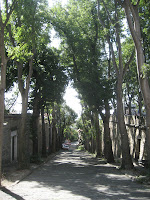Piazza di Unita
It was Ferragosto on our first day in town, so much was closed. Being Mary’s holiday it’s supposed to have religious significance, but in the last 40 years or so, it’s been turned into a sort of American Labor Day, an excuse for beach going and parties (the Vatican is not very happy about this and makes a point of getting on TV prior to the holiday to remind people of its original message). We wandered through the piazza, enjoying klezmer (?!) and classical music played by street musicians. We had an amazing lunch at the “wrong” café (we were headed for a guide book recommendation but turned too soon, with excellent results) and walked along the quays to the decrepit old university building, uphill to the duomo of San Giusto, and then back downtown to the Serbian church of San Spiridione (Trofie Wife’s favorite; loved the gilt).
Inside San Spirito
We sipped café shakerati (iced espressos) and ate apple strudel filled with raisins and pignoli at the famed Café degli Specchi, right on the Piazza d’Unita. There is a bit of a pigeon problem at the many outdoor cafes, with the brazen birds landing on tables (cleared and with patrons still around) in hopes of getting some crumbs. They are probably responsible for breaking at least a dozen glasses a day at each venue. We returned to the piazza at nightfall (after a pre-dinner gelato; despite the heavy Austrian influence, the gelato is still 100 percent Italian and fantastic) for a jazz concert with a fairly well-known (though not to us) Italian jazz elder. The piazza was lit up and filled with people from front to back; it was quite a sight. We capped off the evening at a beer garden overlooking the water.
Sunday was devoted to Jewish activities. We toured the impressive synagogue (Tempio Israelitico di Trieste) and learned about the community, past and present. During the community’s heyday from the mid-1800s to just prior to World War II (the Jewish population was around 5,000 just prior to the start of the war), it was Ashkenazi (German and Eastern European) and filled with major players in the Trieste Trieste
We spent the afternoon at perhaps the most embarrassing historical site in all of Italy Auschwitz, Buchenwald, or other death/labor camps, so the Riseria’s main victims were Slavs and Italian partisans and communists (a total 3,000-5,000 people were murdered here; but it mostly served as a transit camp). The museum appears to do an excellent job reaching out to its neighbors in Slovenia and Slovakia
After recovering from the intensity of the camp, we spent the next morning learning about Trieste Trieste DVD about his time in the city, particularly learning about his experience tutoring the well-to-do Jewish families and writing alongside Italo Svevo, an Italian-Jewish businessman and author (Joyce helped put his self-published work on the map). Many believe that much of the character development of Leopold Bloom of Ulysses emerged from these relationships. In addition, there’s a strong theory that the language of Finnegans Wake was inspired by Trieste, where at every street intersection a different language could be heard—some critics have gone so far as to say that Trieste is the only city that could have inspired the ruckus within the Wake!
Trofie Wife discusses literature with Svevo
Our last tourist stop within the city limits was to Miramare, a Hapsburg castle built by Archduke Ferdinand Maximilian, the loopy one who was named emperor of Mexico Vienna Adriatic on our way back to the hotel. There isn’t really a beach on this part of the coast; instead people just lay out on the sidewalk or park benches. Gotta love Italian improvisation!
Miramare
Trofie Wife surveys her holdings
Baci e gelato,
Martello e Trofie






















No comments:
Post a Comment